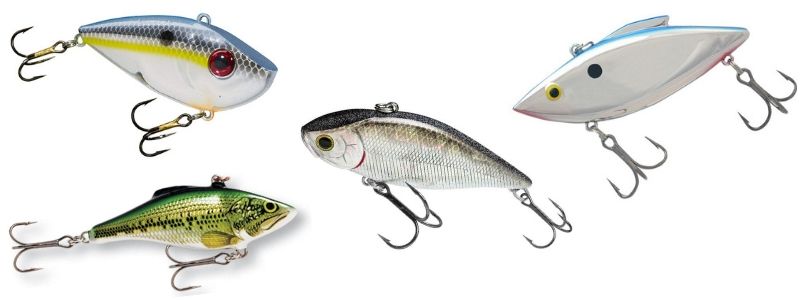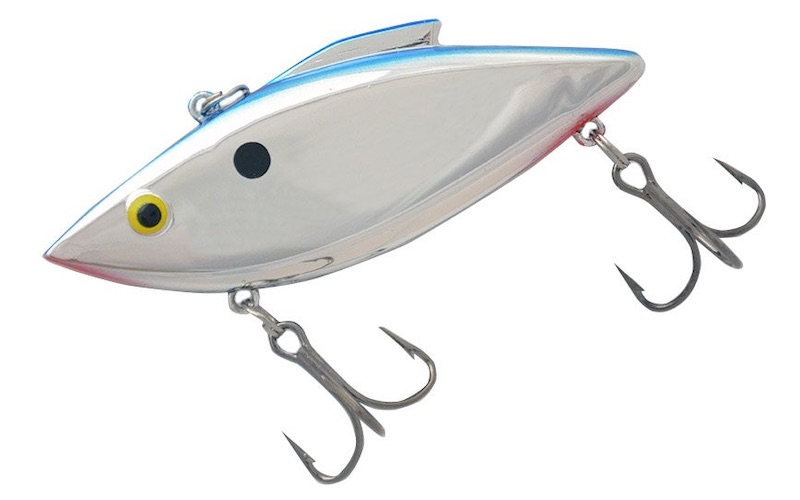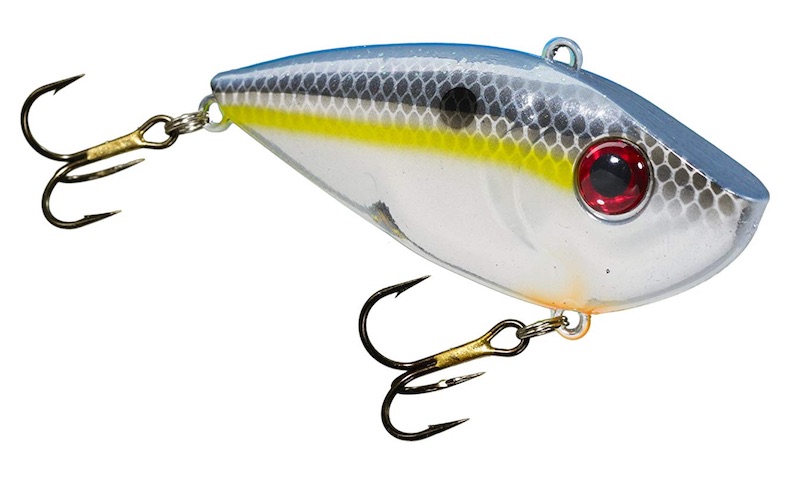
Although they’re called crankbaits, there’s a lot of differences between a lipless crankbait and a regular crankbait. Of course the biggest difference being the lip, or lack thereof. Really the only similarity between the two baits is that they wobble when they are retrieved.
But with a lipless crankbait it’s more of a vibrating action than a wobble, some anglers actually call them vibrating baits. The action is more similar to a blade bait than a crankbait. The other thing they both have in common is they are both typically equipped with two sets of treble hooks.
Lipless crankbaits have a thin body with flat sides, as if a regular crankbait were flattened in a vice. Instead of the lip giving the bait its action, it’s the flattened body that creates the action. As the bait moves through the water at at fast enough speed, it vibrates from side to side.
This action creates a huge racket in the water, while also putting out a ton of vibration that bass can feel in their lateral line. To enhance this even more, most lipless crankbaits have rattling beads or knockers inside them.
Types of Lipless Crankbaits

The first lipless crankbait was called the Diamond Wiggler, a vintage bass lure created in the early 1900’s. Since then it seems like every lure company has come out with their own lipless crankbait. Hundreds have been made that all use the same method of creating this vibrating action.
Lipless crankbaits really don’t change in appearance that much from bait to bait, but they all make different sounds. Since most of them have rattles, the best way to determine which one you want to use is to simply shake it in your hand. That will give you a good idea of what kind of noise it’s going to make in the water.
But the one lipless crankbait that made the biggest initial splash was the Rat-L-Trap made by Bill Lewis. So much so, that the name “Rat-L-Trap” soon became a general term that anglers use to refer to any lipless crankbait.
Rat-L-Trap
This is the household name brand when it comes to lipless crankbaits. Rat-L-Traps have an oval shape to them but with pointed ends. Kind of an unnatural shape but these baits have been producing for years. In the early days it was all about the chrome colors, but now they offer a ton of different colors.
Since the original Rat-L-Trap, Bill Lewis has come out with a handful of additional versions. While most of them sink, they do have a floating model. Rat-L-Traps range from a quarter ounce to one ounce in weight, and two and a half inches to four inches in length. But half ounce is the most standard size for these or any lipless crankbait.
Red Eye Shad
The Red Eye Shad is a newer lipless crankbait made by Strike King. What sets this bait apart from the others is how it falls. It is a really well-balanced bait, so it won’t roll on its side as it sinks. Instead it has a really nice fluttering action as it falls.
There are two types of Red Eye Shads, a rattling version and a knocker version. The Rattling Red Eye Shad is the standard model, and is filled with BB’s that give it a nice rattling sound as it vibrates. Their used to be a silent version that solely relied on its vibration to attract bass, but it was discontinued.
The knocker version is called the Tungsten 2 Tap, which makes more of a knocking sound. It has a single tungsten ball inside a chamber within the bait that bangs back and forth as the bait vibrates.
Fishing Lipless Crankbaits
One of the biggest advantages of fishing lipless crankbaits is the amount of water you can cover. These are power fishing lures, and one of the fastest moving power fishing lures out there. Even when working them with slower retrieves the bait will be moving at a good clip.
Not only that but you can cast them a mile. Because of their narrow bodies you can launch these baits out further than most other lures. This allows you to cover a good length of water during each retrieve.
You can also hit any depth you want, unlike with conventional crankbaits where you would need to change to baits rated for different diving depths. With lipless crankbaits you just let the bait sink to the depth you want to target. Again, adding to why these baits are great for covering water.
But it’s not just about covering water, you also want to be enticing fish during while making these casts. There are a few ways to work a lipless crankbait, but using the right rod will help a ton. You should be using a medium power, fast action rod for lipless crankbaits.
And because most of these baits sink, the best line to use is Fluorocarbon. Let’s take a look at a couple effective ways to work these baits.
Rip and Flutter
This is the most popular, and arguably the best way to fish a lipless crankbait. It basically means sweeping the rod quickly to make the bait rip through the water, then reeling in the slack as you slowly return the rod to its initial position.
When you rip the bait like this it causes it to vibrate aggressively. This creates a ton of noise and water disruption that bass can easily detect. It also creates an attracting flash, similar to the flash that a baitfish would give off when in distress.
When you are reeling in the slack the bait will sink down in the water column. This creates the appearance that the bait is struggling, using bursts of energy to swim but without enough strength to keep it going. But to a hungry bass all this looks like is an easy meal.
Some lipless crankbaits fall differently than others, so you should make sure to see what the one your fishing does as it falls. They also have different sink rates to count down as you watch it sink so you know how long to make the bait flutter down before ripping it again.
Straight Retrieve
Fishing a lipless crankbaits the way you would work a regular crankbait can be very effective as well. But you can burn them much faster and when fish are aggressive this can be very effective. One very popular technique is to burn the bait over grass beds, or slightly ticking the tops of the grass beds.
One of the nice things about lipless crankbaits is how smoothly they come through grass. But even if you snag a weed you can usually shake it free pretty easily. If you feel the bait is heavy, or is not vibrating normally, all you have to do is give the rod a good yank and it should shake the weeds loose. This motion can also trigger a reaction strike.
And you don’t have to have weeds on the hook to trigger reaction strikes. Mixing in a little irregularity from time to time like this while reeling in a straight retrieve is a great lipless crankbait technique. This can be done by just giving the bait a quick rip like that randomly through the retrieve.





